I have no legs today when I wake up, despite yesterday being short (50 KM) and rather sightseeing than cycling. Maybe the Namibian tourist season is picking up, because the Twyfelfontein campsite was quite busy. I had a group of young Koreans setting camp just next to me, and they decided to cook noodles on the fire at midnight, while screaming whenever an insect showed up. Not good for my much needed sleep, probably my second priority after food.
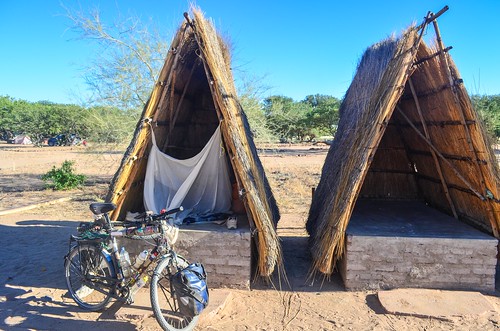
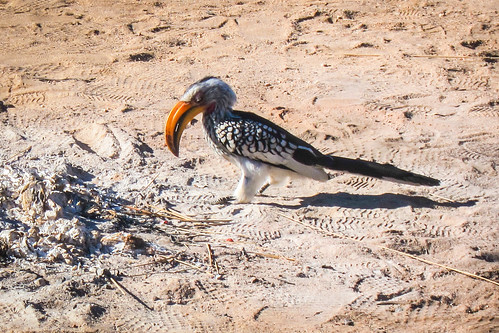
The landscape through Damaraland is as stunning as usual, as I leave Twyfelfontein to return to larger roads towards the small mining town of Uis.
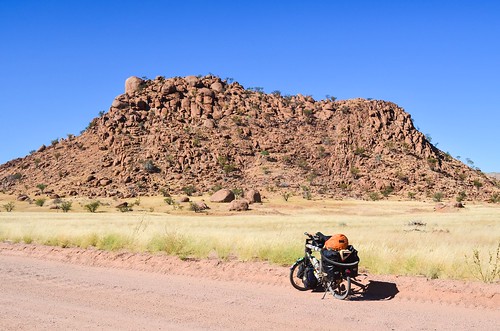
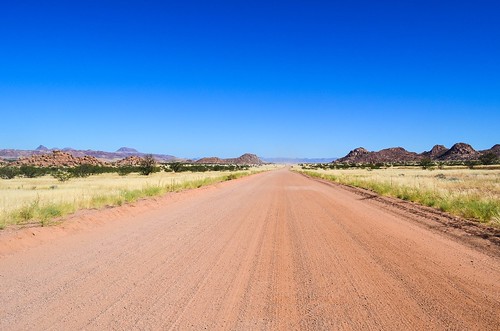
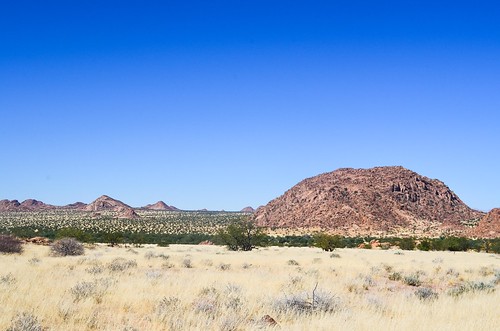
Daramaland is grandiose. If I have enough food in the belly and water on my racks, like today, I can fully enjoy the scenery. The number of pictures I take everyday seems to correlate not only with the quality of the views, but also with ability to forget about basic needs like eating.

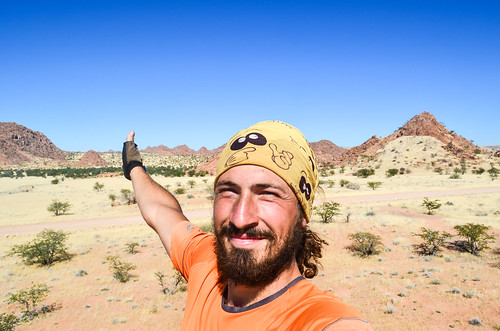

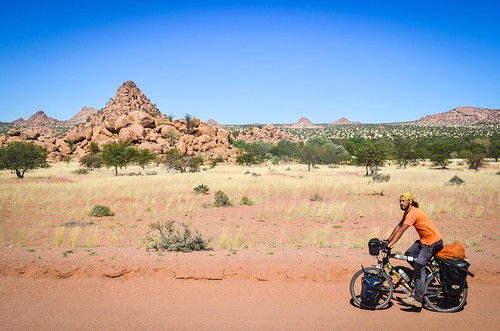
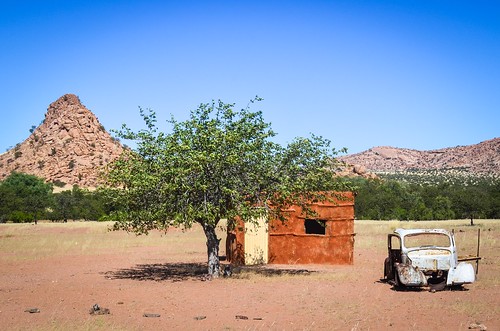

The roads are nice but far from being perfect. Corrugations appear soon and it’s a pain to cycle. With washboarding, I’d say annoying flies and the lack of water are the three most irritating features of cycling in Namibia.
I end up breaking my 9th spoke. I didn’t hear a spoke snapping since Ghana, it has been a long time worry-free since then. The only shade I found was in the shadow of a road sign for an immediate change. Out of nine broken spokes, it has been five times the same one. I guess it means something has to be fixed for good, but I am no spoke expert and can only change them. I have enough spares now.
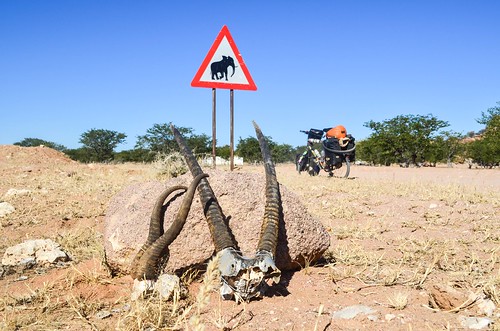
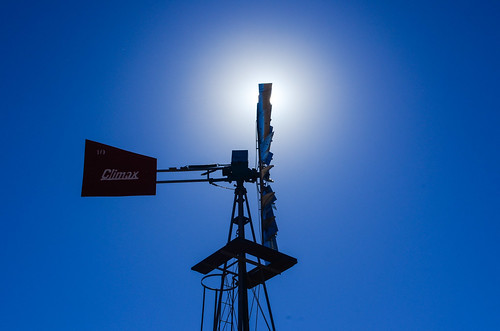

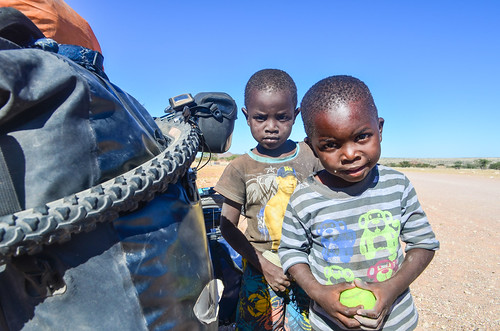
After the first 60 kilometers, I reach the information center of Sorris Sorris at the junction with the C35. There is so few houses around here that I am surprised to see such a thing … but it’s helpful to refill on water. It strongly tastes like limestone, but I can’t complain.
I am now on the main road between Khorixas and Uis. The lady of the information center informs me that elephants have been roaming around recently. They were right here, on the road, yesterday. She advises me to set up my tent inside the fenced ground for my safety.
It would be nice indeed, but it’s only 4:30 and I don’t want to miss my favorite hour of the day, the last one. Plus, after last night bad sleep, I want to be as far as possible from anyone, so I will go and tease the elephants.
There are two parallels roads to Uis, the main C35 and the D2319 via Sorris Sorris. I pick the smallest one which looks in good shape. And a few minutes later, I start seeing elephant poop on the road.
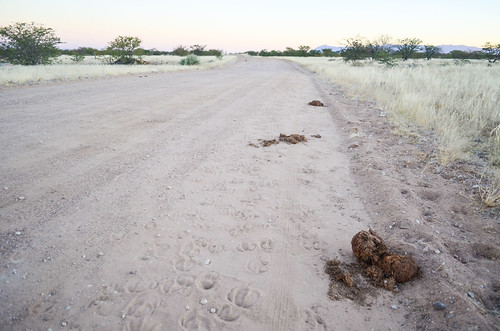
The desert elephants are wild but inoffensive, … well, of course, it’s not a good idea to stand in their way. The poops are numerous, every 100 meters or so, and I am now expecting to see them sooner or later on the road.
But even if they disappear after some time, I don’t feel confident about wild camping anymore. These elephants are certainly around. What if I wake up in the night and see elephants by moonlight walking towards my tent? It was a bad idea to ignore the suggestion of the lady one hour ago.
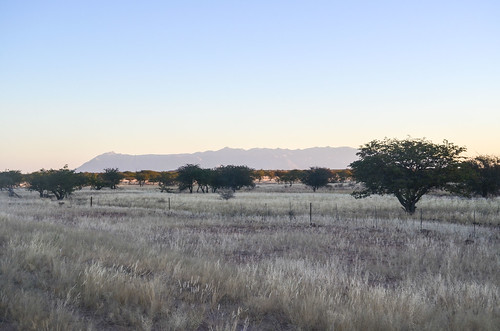
The rocky hill in front of me seems close, but despite cycling fast, I can’t reach it. I settle for a corner of savannah, close to a dry river bed, after making sure that I see no footsteps or droppings of elephants around. Every suspicious noise sounds like a herd of elephants, but it’s just my imagination.
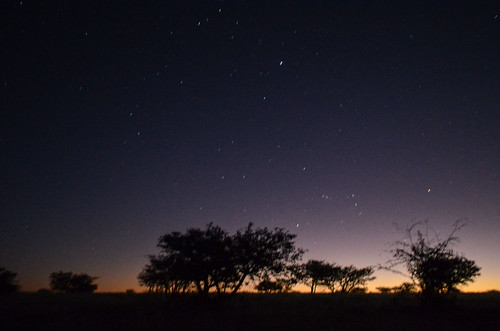
As I am cooking, I still watch around for a potential threat. The moonlight lets me guess shapes on the horizon. Was that dark spot there earlier? Is it moving?
Eventually, no elephant comes to visit me, but the omnipresent armored crickets are hungry. Some come too close to my tent … so I step on them. I still don’t like them. And to make sure these dead cannibals won’t be attracting their friends, I bury them in the sand.
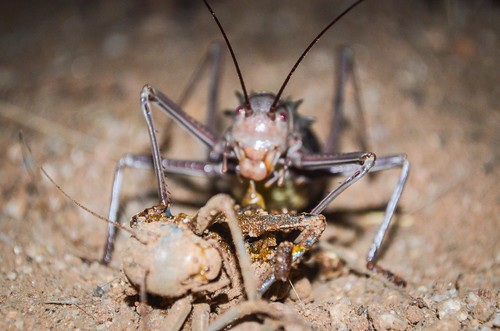
It’s pointless: other crickets will dig up their favorite food. They also don’t mind attacking live ones.
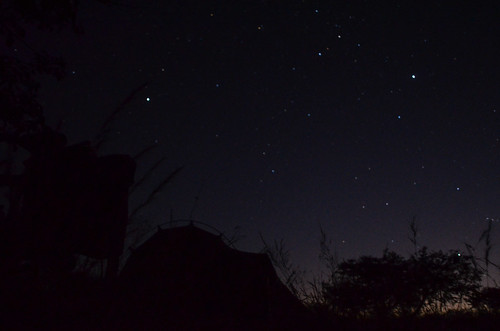
I realized only later that the mountain I wanted to reach is the Brandberg mountain range, the highest of Namibia, and … another 60 km further! The landscape is bare so it looked close. No way I could reach it that evening, but it is my objective today.
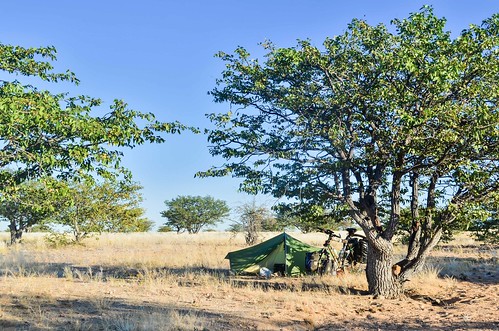
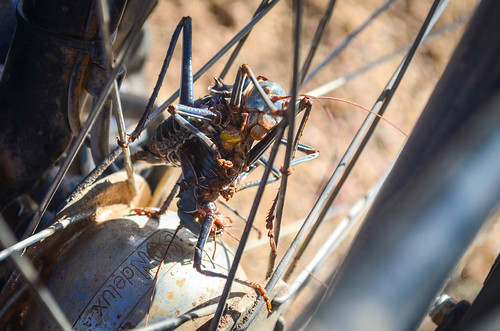
It’s a good thing I didn’t meet the elephants at night, but maybe I’ll see them today. Unfortunately that narrow Sorris Sorris road doesn’t seem to be used. In the first kilometers, I get corrugations AND sand at the same time, and it’s just impossible to ride most of it.
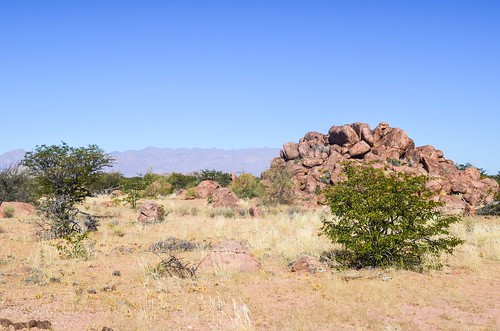
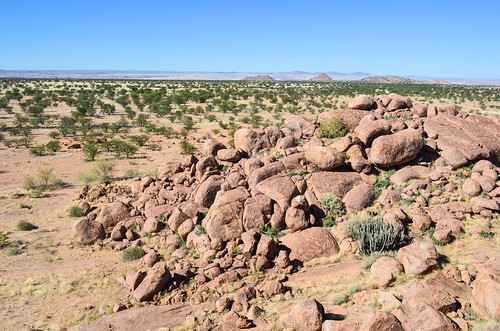


The remaining 20 km of this road are terrible. I walk and push my bike for most of the time, as I get corrugations on the way down to the Ugab river, and sand on the way up after it. The Ugab river is the same I passed by near Vingerklip, and it doesn’t have any water here either. I hesitate to continue inside the river bed, it would be a shortcut until Brandberg mountain, but despite the 4×4 tracks, it may not be possible for my tires.

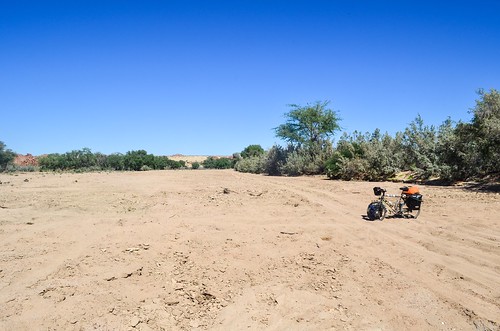
I am fed up when I get back onto the C35. I lost lots of time and water for just a few kilometers, and I am about to change my mind about Brandberg. The White Lady, a site inside the Brandberg mountains which features bushmen paintings, is 21 km off the road. It means going down again to the Ugab river, and adding on my legs 42 kilometers of a road I can’t ride. I have no more water and I just want to cycle straight to the town of Uis, 15 km ahead, buy chocolate and the biggest bottle of Coca-Cola, and do nothing else.
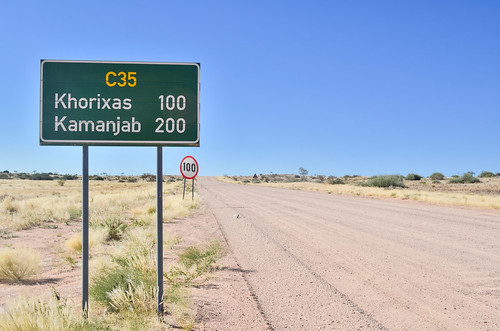

I’m not particularly interested in rock paintings, but I would enjoy being on that mountain. In a moment of wisdom, I convince myself that the instant gratification of a cold drink will fade quickly, and is worth nothing compared to the memories I can make by pushing myself for more dirt road. I turn right.

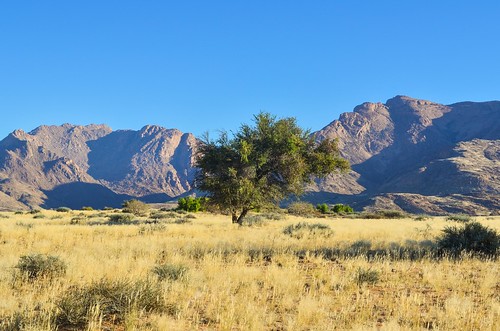
The Brandberg White Lady lodge is not exactly at the same site of the paintings, and for me it has priority over it. This is another lodge with all the comfort one can expect (and a campsite) in the middle of nowhere. I’m counting down the last 7 or 8 kilometers of sand until there, go straight to the bar, get my drink and jump in the pool. I feel like a red-hot iron rod plunged into water for cooling, and I need that to cool down and relax.
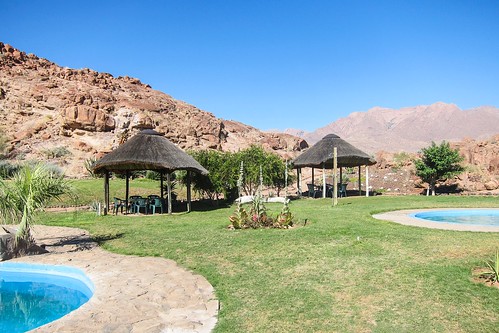
The owners invite me to stay for a lamb braai and I end up going to the campsite only at night to set up my tent. I’m staying there for a day, I can’t get back on the saddle tomorrow and a rest day is what I need. The lamb felt good too, since without roadside food in Namibia, I eat spaghetti (the densest transportable food) all the time. My stomach forgot how did the all-you-can-eat impala steak buffet at Etosha NP taste like.
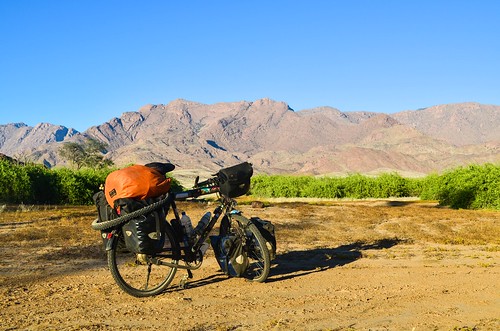
The armored crickets are all over. As I am on my laptop at the bar, someone says the desert elephants are just a few kilometers away. They were not seen this year yet, only one passed by last January, four months ago, so it’s a lucky day for me! They are 25 of them walking towards the lodge and will stop by the waterhole, near the campsite.
Elephants walk all the time and they need to drink every day, at least 100 liters of water a day. Apparently, they know how to dig inside the riverbed of dry rivers to make underground water appear. One lodge manager says there are about 80 wild elephants in the region, divided into three groups. The elephants at Twyfelfontein two days ago must have been one group.

However, when I get ready to walk to the campsite waterhole, they have already left! So I start running in their direction in the riverbed, but to make it a bit safer, I stay somehow at a higher level on boulders. I don’t want to test the techniques of surviving a charging elephant.
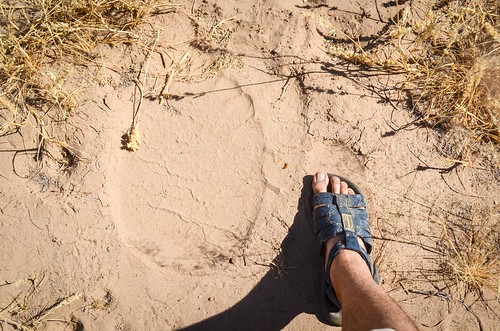
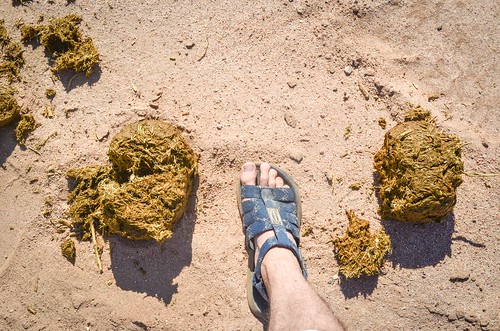
After half an hour of tracking, I finally find them, and can count 12 desert elephants in the Ugab riverbed.


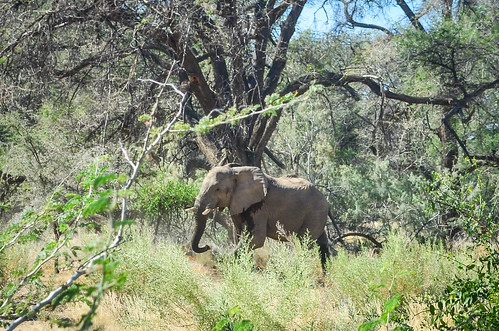
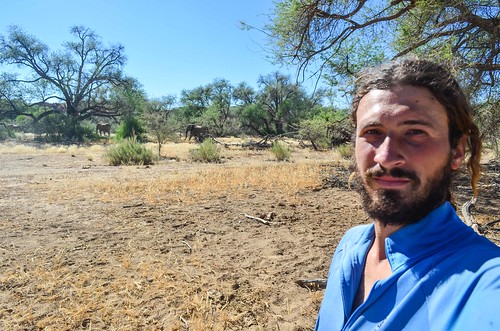
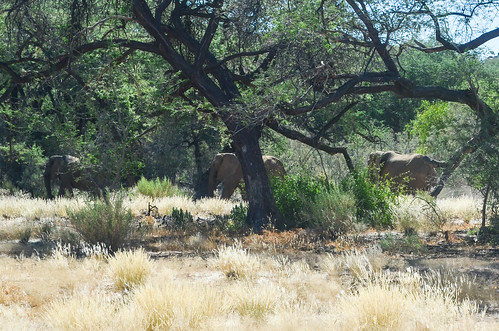


After two days making most of the buffet breakfasts, I feel motivated again to tackle the heat and sand. I even try a small shortcut through the local farmhouses, where the sand is fortunately not as bad as where I came from, and where the wooden structures fit nicely between the Brandberg boulders and yellow grass.


The Brandberg massif is the highest mountain of Namibia, peaking at 2573 m. It formed 130 million years ago through volcanic activity: it is believed that when continents were still moving around present-day Namibia, magma pushed up from the bottom, but failed to reach the surface and create a volcano. That explains why the granite mountain range is almost circular, with a 25 km diameter, while the rest of Damaraland has no particular peaks.
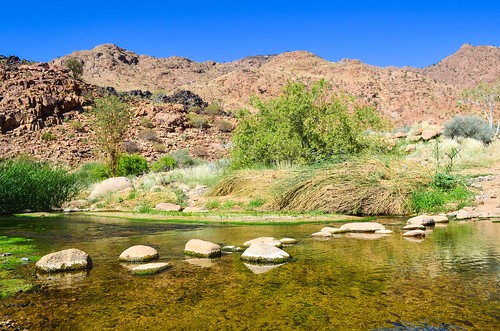
The eastern side has a valley allowing hikers to walk up to the While Lady. To my surprise, there is a small river flowing inside. I have not seen so much water for a long time! The water comes from the previous rainy season, and the tadpoles enjoy swimming in it, while I enjoy drinking it.
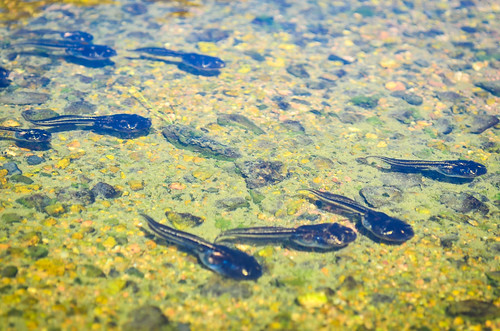

There are bushmen paintings in 900 sites in the massif, maybe from the same people who left the rock engravings of Twyfelfontein behind. The White Lady painting is 2000-6000 years old. It is called the White Lady after the name given by a French priest and archaeologist, Henri Breuil, who also put light on the Lascaux caves.
But he was wrong, and the White Lady is not an Egyptian lady. Not even a lady. It’s a man, a bushman medicine man. Painted with four different colors, made from animal blood or crushed stones, the paintings are remarkably well conserved.



With that time spent at the breakfast buffet of the lodge and the paintings of the Brandberg, I have just enough time to reach Uis and its mini-supermarket. It’s Friday today, I’m almost out of food, and in case nothing is open during the whole week-end, I’d better get there before 5 pm.
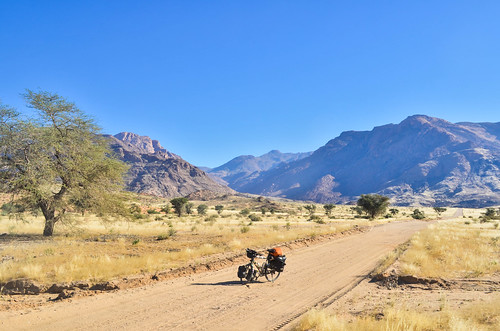
Uis means “rock” in Damara. It was marked “15 km” from the junction with the C35, but it’s actually more than 20 km away. It’s never showing up … but I finally get there just in time before they close the supermarket.

Being in Namibia means being back on the tourist beaten trail: most trans-Africa travelers go this way, and then switch east through Botswana and Zambia. I meet an Australian motorbiker at the rest camp, Ashley, who knows Yves the French cyclist, who had cycled last year with Cindy, who has been through West Africa just before me, while I was cycling with Johannes, who is now in Swakopmund, where he met this same Yves and another American cyclist. If I stop in Windhoek at Mark’s place who has hosted Dave and Emma, it makes the world of cyclists in Africa a very small one. I’d say there are about 10 cyclists with a website who try to cross the whole continent every year. If we consider that half of the cyclists write a website while touring, it might make 20 cyclists on the road in total.
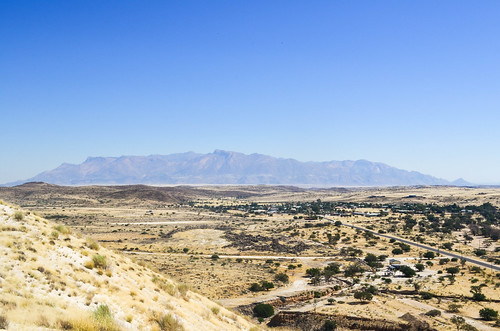
Uis is a tiny town of 2000 far away from everything. My last town was Khorixas, six days ago (only 131 km away via the main road, but I made a long detour). The reason why Uis exists is the presence of a large tin deposit. “Tin was discovered in 1911 and the belt extends until Cape Cross on the coast. Uis is probably the largest tin-bearing pegmatite in the world. The town was established in 1960 to house the personnel of the tin mine. ”
It produced 140 tons of tin a month at its peak and closed down in 1990 because the price of tin dropped. You can’t mistake the mining activity when you reach the town: the mine tailings really overwhelm the town.

In the morning of my departure towards Brandberg West, another very tough road, I pay a visit to the dilapidated mine buildings and get a nice view point at the top of the tailings.
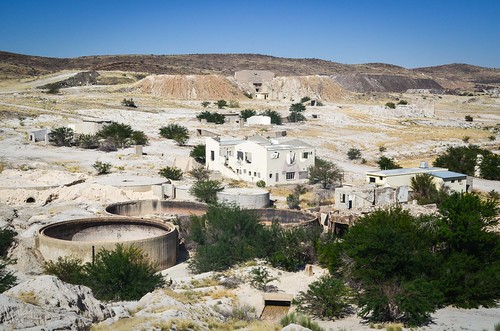
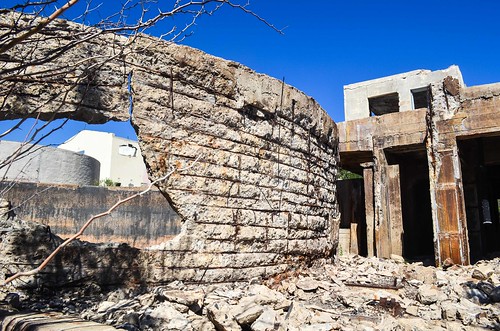
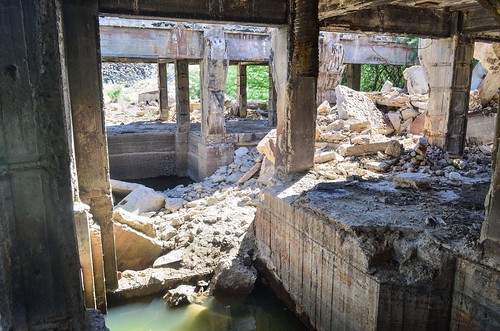
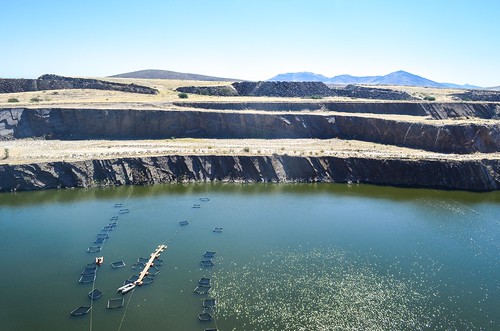
There is also a secret lake hiding in the tailings on the other side of the road, used for fish breeding.
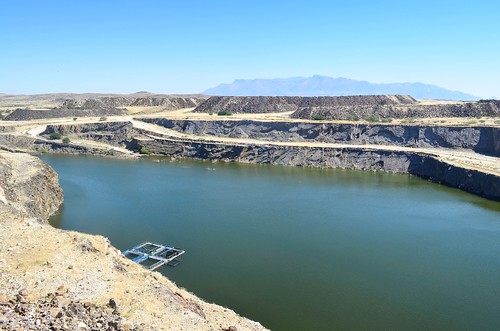
Since I like abandoned mines, I am going now for another one, but a very remote one, the Brandberg West mine. I have loads of food and my maximum water capacity, 10 L, because I know I will be out of cellphone coverage and won’t see anything for the next three days …





Cool. I cycled Namibia back in 2007 – and will return in september this year, and will probably spend som time on smaller roads in Damaraland. Great info here!
Cheers
Lars
http://www.lostcyclist.com/cv
Hi Lars, so you’re the one who cycled with helenstakeon … Indeed Damaraland is so scenic. If you liked your rides in the deserted Atlas, you’ll like it there too! (without the Tizi n’steepstuff though). Check the next post too: http://freewheely.com/2014/07/mining-expedition-in-the-desert-of-brandberg-west/
Yes it was! 🙂
Arrived in Namibia last night and are doing some last minute research in Windhoek now!
Branberg west sounds interesting, but It would have been great if you could go from D2342 up north to C-39 and on to Khorixas…. But I guess the eastern side of the mountain is beautiful enough. 🙂
Yes you can! Most of the maps won’t show it, because it’s a 4×4 trail, and people are strongly advised to travel in a convoy. No water for sure and maybe desert lions. On the top of this, I wouldn’t do it because it must be very rocky and I’d be afraid to break a pedal or something just by pushing the bike. But do let me know if you try it!
Great pictures – it’s already an adventure following you on this travel book. Thanks a lot!
Thanks Jens!
Merci
Bon choix ,les peinture rupestres sont’elles dans des grottes ou en plein air car elles sont magnifiquement conservées et beaucoup plus graphiques qu’une bouteille de coca !!! Finalement c’est presque au bout du périple que tu as as vu les éléphants, un peu de stress quand même la nuit.
Le white lady painting est sous un rocher en surplomb, derriere une barriere pour la proteger du vandalisme.
Ouais, finalement les animaux ne sont visibles que la ou il y a des mesures en place pour les protéger, et ca fait pas beaucoup de pays.
Beautiful pictures! SO pleased you found desert elephant. You did better than us this time.
It was there first time in Brandberg this year, you can’t force nature 🙂
It seems they are more regular in Twyfelfontein, you didn’t see them there or in Purros?